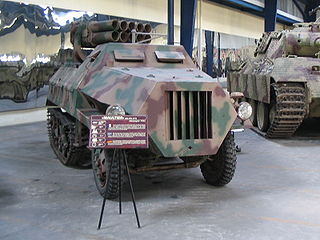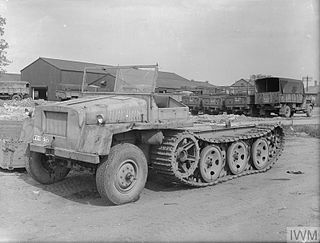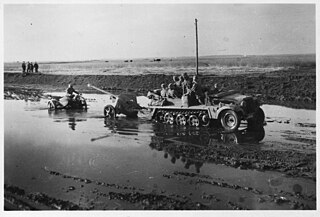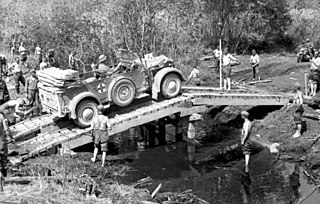
This article lists production figures for German armored fighting vehicles during the World War II era. Vehicles include tanks, self-propelled artillery, assault guns and tank destroyers.

A half-track is a civilian or military vehicle with regular wheels at the front for steering and continuous tracks at the back to propel the vehicle and carry most of the load. The purpose of this combination is to produce a vehicle with the cross-country capabilities of a tank and the handling of a wheeled vehicle.

The Sd.Kfz. 251 half-track was a World War II German armored personnel carrier designed by the Hanomag company, based on its earlier, unarmored Sd.Kfz. 11 vehicle. The Sd.Kfz. 251 was designed to transport the Panzergrenadier into battle. Sd.Kfz. 251s were the most widely produced German half-tracks of the war, with at least 15,252 vehicles and variants produced by seven manufacturers. The utility of this vehicle led the German Army to develop the similar looking but shorter and lighter Sd.Kfz. 250 as a supplement.

The Sd.Kfz. 6 was a half-track military vehicle used by the German Wehrmacht during the Second World War. It was designed to be used as the main towing vehicle for the 10.5 cm leFH 18 howitzer.

Opel Blitz was the name given to various light and middleweight trucks built by the German Opel automobile manufacturer between 1930 and 1975. The original logo for this truck, two stripes arranged loosely like a lightning symbol in the form of a horizontally stretched letter "Z", still appears in the current Opel logo. The Blitz name was then applied to the British-made Bedford CF when it replaced the Blitz in certain markets.

The Sd.Kfz. 7 was a half-track military vehicle used by the German Army, Luftwaffe and Waffen-SS during the Second World War. Sd.Kfz. is an abbreviation of the German word Sonderkraftfahrzeug, "special purpose vehicle". A longer designation is mittlerer Zugkraftwagen 8t, Sd.Kfz. 7, "medium towing motor vehicle 8t".

The German Panzerwerfer refers to either of two different types of half-tracked multiple rocket launchers employed by Nazi Germany during the Second World War. The two self-propelled artillery vehicles are the 15 cm Panzerwerfer 42 auf Selbstfahrlafette Sd.Kfz.4/1 and 15 cm Panzerwerfer 42 auf Schwerer Wehrmachtsschlepper.

The Schwerer Wehrmachtschlepper was a German World War II half-track vehicle used in various roles between 1943 and 1945. The unarmored models were used as supply vehicles and as tractors to haul artillery. Armored versions mounted anti-aircraft guns or a 10 barrel rocket launcher (Nebelwerfer). Fewer than a thousand were built before the end of the war, but production continued after the war of an improved model in the Tatra plant in Czechoslovakia.

The Sd.Kfz. 4 was a 4.5-tonne military truck of Maultier ("mule") half-track family developed during World War II by Germany. Its manufacturer designation was Mercedes-Benz L4500R.

The Sd.Kfz. 10 was a German half-track that saw widespread use in World War II. Its main role was as a prime mover for small towed guns, such as the 2 cm Flak 30, the 7.5 cm leIG, or the 3.7 cm Pak 36 anti-tank gun. It could carry eight troops in addition to towing a gun or trailer.

The Sd.Kfz. 11 was a German half-track that saw widespread use in World War II. Its main role was as a prime mover for medium towed guns ranging from the 3.7 cm FlaK 43 anti-aircraft gun up to the 10.5 cm leFH 18 field howitzer. It could carry eight troops in addition to towing a gun or trailer.

Raupenschlepper Ost was a fully tracked, lightweight vehicle used by the Wehrmacht in World War II. It was conceived in response to the poor performance of wheeled and half-tracked vehicles in the mud and snow during the Wehrmacht's first autumn and winter on the Soviet Front.

The Sd.Kfz. 9 was a German half-track that saw widespread use in World War II, and the heaviest half-track vehicle of any type built in quantity in Nazi Germany during the war years. Its main roles were as a prime mover for very heavy towed guns such as the 24 cm Kanone 3 and as a tank recovery vehicle. Approximately 2,500 were produced between 1938 and 1945.

The Sonderkraftfahrzeug 8, usually abbreviated to Sd.Kfz. 8, was a German half-track designed by Daimler-Benz that saw widespread use in World War II. Its main roles were as a prime mover for heavy towed guns such as the 21 cm Mörser 18, the 17 cm Kanone 18 and the 10.5 cm FlaK 38. However, it was also capable of serving as an infantry transport. Approximately 4,000 were produced between 1938 and 1945. It was used in every campaign fought by the Germans in World War II, notably the Invasion of Poland, the Battle of France, the Balkans Campaign, the Eastern Front, the North African Campaign, the Battle of Normandy and the Italian Campaign.

Einheits-Pkw der Wehrmacht – literally: "standard passenger motor-car of the Wehrmacht" – was the Nazi German plan for a new, multi-purpose fleet of all wheel drive off-road vehicles, based on just three uniform chassis, specifically designed and built for the Wehrmacht. The plan was formulated in 1934, and vehicles were built from 1936 to 1943.

The Borgward B 3000 was a medium-sized truck made by German manufacturer Carl F. W. Borgward GmbH between 1941 and 1944 in the Bremen-Sebaldsbrück works. After World War II, B 3000 production continued from July 1948 to 1950. There was also an electric version named Borgward BE3000.
















